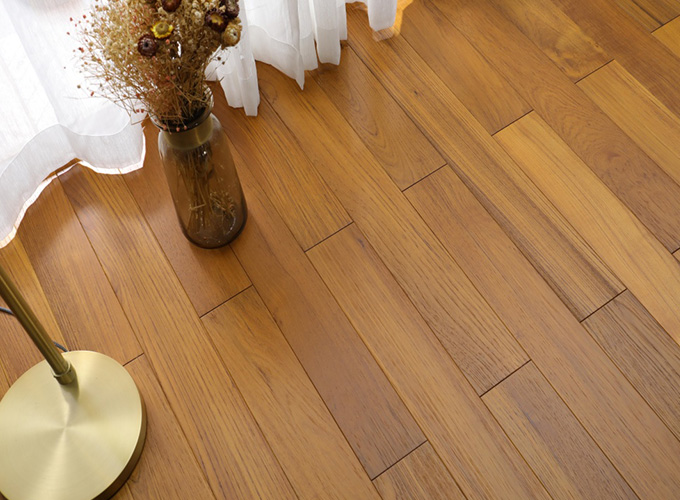Laminated flooring has revolutionized the world of interior design and home improvement, offering an affordable, versatile, and aesthetically pleasing alternative to traditional flooring materials like hardwood, tile, or carpet. Composed of multiple engineered layers, laminated flooring combines practicality with visual appeal, making it a popular choice for both residential and commercial spaces. This article explores the composition, benefits, applications, and future trends of laminated flooring, highlighting why it has become a cornerstone of contemporary interior design.
1. Composition and Manufacturing Process
Laminated flooring is a multi-layered product designed to mimic the appearance of natural materials while enhancing durability. Its structure typically includes four key layers:
Wear Layer: The topmost layer is a transparent, melamine-coated surface that resists scratches, stains, and fading. This protective shield ensures the flooring withstands daily wear and tear, making it ideal for high-traffic areas.
Decorative Layer: Beneath the wear layer lies a high-resolution photographic image that replicates the look of wood, stone, or tile. Advanced printing technology allows for endless design possibilities, from oak and maple to abstract patterns.
Core Layer: The core is composed of high-density fiberboard (HDF) or medium-density fiberboard (MDF), providing structural stability and moisture resistance. Some premium products incorporate waterproof cores for enhanced performance in humid environments.
Backing Layer: The bottom layer acts as a moisture barrier and stabilizer, preventing warping and ensuring the flooring remains flat during installation.
The layers are fused together under high pressure and temperature, creating a unified, robust panel. This manufacturing process ensures consistency in quality and appearance across all planks.
2. Key Advantages of Laminated Flooring
a. Affordability and Cost-Effectiveness
Laminated flooring is significantly cheaper than solid hardwood or natural stone, offering a budget-friendly option without compromising aesthetics. Its lower installation costs—thanks to click-lock systems that enable floating floors—further reduce expenses.
b. Durability and Low Maintenance
The wear layer’s resistance to scratches, dents, and UV rays makes laminated flooring ideal for homes with pets, children, or heavy foot traffic. Unlike hardwood, it doesn’t require polishing or refinishing. Routine sweeping and occasional damp mopping are sufficient to maintain its appearance.
c. Design Versatility
From rustic reclaimed wood to sleek marble effects, laminated flooring offers limitless design choices. Modern embossing techniques even replicate the texture of natural materials, adding a tactile dimension to its visual appeal.
d. Easy Installation
Most laminated flooring uses a click-lock or tongue-and-groove system, allowing planks to snap together without nails or glue. This DIY-friendly feature enables quick installation, even for novices, and minimizes disruption during renovations.
e. Moisture Resistance
With advancements in core technology, many laminated floors now feature waterproof or water-resistant properties. These products are suitable for kitchens, bathrooms, and basements, where traditional hardwood might warp.
3. Applications in Residential and Commercial Spaces
Laminated flooring’s adaptability has led to its widespread adoption across diverse settings:
Residential Use: Homeowners favor it for living rooms, bedrooms, and kitchens due to its warmth, ease of cleaning, and ability to complement modern décor.
Commercial Use: Offices, retail stores, and hotels utilize laminated flooring for its durability, cost-effectiveness, and professional appearance.
Specialized Environments: Waterproof variants are increasingly used in spas, gyms, and healthcare facilities where hygiene and moisture resistance are critical.
4. Sustainability and Environmental Considerations
As consumers prioritize eco-friendly products, manufacturers have responded by adopting sustainable practices:
Recycled Materials: Some laminated floors incorporate recycled wood fibers or post-consumer content in their core layers.
Low-VOC Emissions: Many products meet stringent indoor air quality standards (e.g., FloorScore or GREENGUARD certification), reducing harmful volatile organic compound (VOC) emissions.
Responsible Forestry: Brands sourcing wood from FSC-certified forests ensure ethical and sustainable forestry practices.
However, challenges remain. While laminated flooring is more sustainable than vinyl, its synthetic components can complicate recycling. Innovations in biodegradable adhesives and recyclable cores aim to address these issues.
5. Challenges and Limitations
Despite its strengths, laminated flooring has drawbacks:
Moisture Sensitivity: While waterproof options exist, standard laminated flooring can swell if exposed to prolonged standing water.
Lifespan: With an average lifespan of 15–25 years, it is less durable than hardwood or tile, which can last decades with proper care.
Sound Transmission: Laminate floors can produce a hollow sound underfoot, though underlayments with noise-reduction properties mitigate this issue.
6. Innovations and Future Trends
The laminated flooring industry continues to evolve, driven by technology and consumer demands:
Waterproof Technology: Brands like Pergo and Mohawk now offer 100% waterproof cores, expanding laminate’s usability in wet areas.
Enhanced Realism: 3D embossing and textured surfaces replicate the grain and knots of natural wood more authentically.
Smart Flooring: Integration with smart home systems, such as heated flooring or embedded sensors, is on the horizon.
Thinner, Stronger Planks: Advances in HDF production enable slimmer profiles without sacrificing durability, appealing to minimalist design trends.
Market analysts predict steady growth for the laminated flooring sector, particularly in Asia-Pacific and North America, driven by urbanization and rising disposable incomes.
Conclusion
Laminated flooring has cemented its place as a go-to solution for modern interiors, balancing aesthetics, functionality, and affordability. Its ability to emulate premium materials while offering superior durability and ease of installation makes it a practical choice for diverse applications. As sustainability and technological innovation take center stage, the future of laminated flooring looks promising, with potential breakthroughs poised to address current limitations. Whether renovating a cozy home or designing a bustling commercial space, laminated flooring remains a versatile and forward-thinking option, embodying the intersection of style and practicality in the 21st century.
 English
English




















